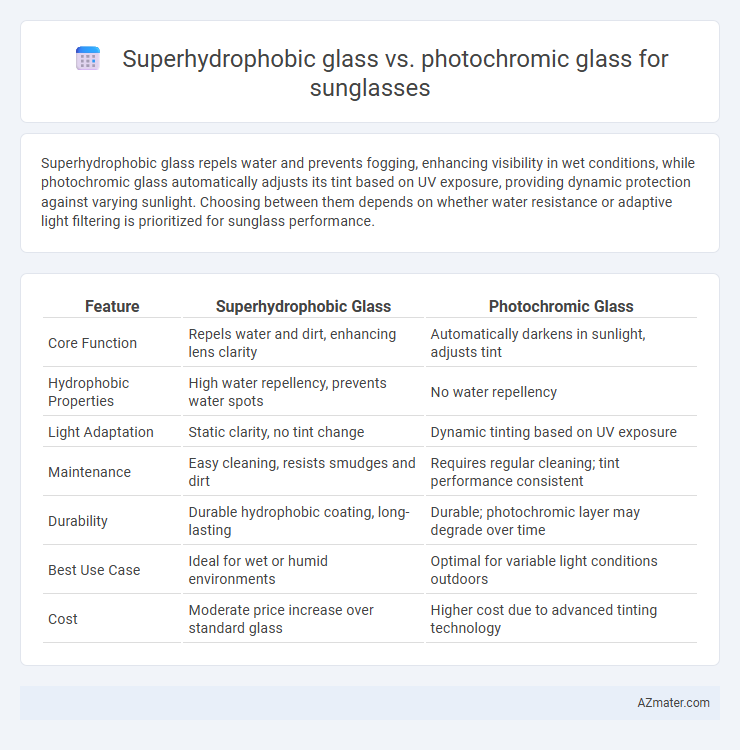Superhydrophobic glass repels water and prevents fogging, enhancing visibility in wet conditions, while photochromic glass automatically adjusts its tint based on UV exposure, providing dynamic protection against varying sunlight. Choosing between them depends on whether water resistance or adaptive light filtering is prioritized for sunglass performance.
Table of Comparison
| Feature | Superhydrophobic Glass | Photochromic Glass |
|---|---|---|
| Core Function | Repels water and dirt, enhancing lens clarity | Automatically darkens in sunlight, adjusts tint |
| Hydrophobic Properties | High water repellency, prevents water spots | No water repellency |
| Light Adaptation | Static clarity, no tint change | Dynamic tinting based on UV exposure |
| Maintenance | Easy cleaning, resists smudges and dirt | Requires regular cleaning; tint performance consistent |
| Durability | Durable hydrophobic coating, long-lasting | Durable; photochromic layer may degrade over time |
| Best Use Case | Ideal for wet or humid environments | Optimal for variable light conditions outdoors |
| Cost | Moderate price increase over standard glass | Higher cost due to advanced tinting technology |
Introduction to Advanced Sunglass Lens Technologies
Superhydrophobic glass repels water and resists smudges, enhancing clarity and durability, making it ideal for active and outdoor use. Photochromic glass dynamically adjusts tint based on UV exposure, providing optimal vision in varying light conditions without needing to switch lenses. These advanced lens technologies significantly improve functionality, comfort, and protection in modern sunglasses.
What is Superhydrophobic Glass?
Superhydrophobic glass features a surface coated with nanoscale structures that repel water, preventing droplets from sticking and improving visibility in wet conditions. This technology enhances the durability and cleanliness of sunglass lenses by reducing smudges, fingerprints, and water spots. Unlike photochromic glass, which changes tint in response to UV light, superhydrophobic glass maintains consistent clarity and performance regardless of lighting conditions.
What is Photochromic Glass?
Photochromic glass is engineered with light-sensitive molecules that darken when exposed to ultraviolet (UV) rays, providing adaptive tinting suitable for varying light conditions. Unlike superhydrophobic glass, which repels water and reduces smudging, photochromic glass enhances visual comfort by automatically adjusting shade intensity. This technology offers protection against harmful UV radiation while maintaining clear visibility indoors or in low-light environments.
Key Differences Between Superhydrophobic and Photochromic Lenses
Superhydrophobic glass features a water-repellent coating that prevents water droplets and dirt from adhering, enhancing visibility in wet and humid conditions. Photochromic glass changes tint in response to UV light, automatically adjusting lens darkness to provide optimal protection against sunlight. The key difference lies in their primary function: superhydrophobic lenses improve water and dirt resistance, while photochromic lenses regulate light exposure by dynamically darkening or lightening.
Benefits of Superhydrophobic Glass for Sunglasses
Superhydrophobic glass offers superior water and dirt repellency, enhancing visibility by preventing water droplets and smudges from accumulating on sunglass lenses. This technology reduces the need for frequent cleaning and maintains optimal clarity in various weather conditions. The added durability and scratch resistance of superhydrophobic coatings also ensure long-lasting performance compared to photochromic glass.
Advantages of Photochromic Glass for Eyewear
Photochromic glass offers adaptive lens technology that darkens in response to UV light, providing optimal vision in varying lighting conditions, unlike superhydrophobic glass which mainly repels water. This feature enhances user comfort and reduces the need for multiple pairs of sunglasses, making photochromic lenses highly convenient for everyday use. Its ability to protect eyes from harmful UV rays while adjusting tint levels ensures superior eye protection and visual clarity.
Durability and Maintenance: Superhydrophobic vs Photochromic
Superhydrophobic glass offers superior durability due to its water-repellent coating that resists dirt, oil, and smudges, reducing the need for frequent cleaning and maintenance. Photochromic glass, while providing adaptive light filtering by darkening in sunlight, tends to degrade over time with exposure to UV rays, affecting both performance and longevity. Maintenance for photochromic lenses often involves careful handling to prevent scratches that can impair the photochromic function, whereas superhydrophobic coatings maintain clarity and resist wear with minimal upkeep.
UV Protection Capabilities Compared
Superhydrophobic glass offers superior UV protection by incorporating advanced nanoscale coatings that repel water and block up to 99% of harmful ultraviolet rays, making it highly effective for prolonged outdoor exposure. Photochromic glass adjusts its tint in response to UV light, providing dynamic UV protection ranging from 60% in low light to nearly 100% in intense sunlight, ensuring comfort and protection throughout the day. While superhydrophobic glass maintains consistent UV defense regardless of conditions, photochromic glass combines adaptability with effective UV filtering, catering to varying light environments.
Price and Accessibility: Which Is More Cost-Effective?
Superhydrophobic glass typically commands a higher price due to advanced nano-coating technology that repels water and dirt, enhancing durability and clarity. Photochromic glass, which darkens in response to sunlight, generally offers more affordable options with widespread availability across various brands. Consumers prioritizing cost-effectiveness and accessibility often find photochromic sunglasses more budget-friendly and easier to purchase compared to premium superhydrophobic alternatives.
Choosing the Best Lens Technology for Your Needs
Superhydrophobic glass enhances outdoor vision by repelling water, dirt, and fingerprints, making it ideal for wet or humid conditions and active lifestyles. Photochromic glass dynamically adjusts tint based on UV exposure, offering versatile protection from varying light conditions without needing to change lenses. Selecting between these lenses depends on whether you prioritize moisture resistance and ease of cleaning or adaptive light filtering for fluctuating environments.

Infographic: Superhydrophobic glass vs Photochromic glass for Sunglass
 azmater.com
azmater.com